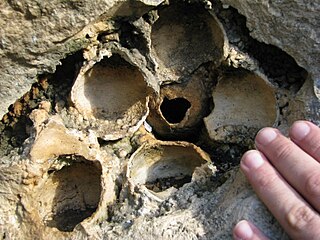
Trapani is a city and municipality (comune) on the west coast of Sicily, in Italy. It is the capital of the Province of Trapani. Founded by Elymians, the city is still an important fishing port and the main gateway to the nearby Egadi Islands.

The National Archaeological Museum of Naples is an important Italian archaeological museum, particularly for ancient Roman remains. Its collection includes works from Greek, Roman and Renaissance times, and especially Roman artifacts from the nearby Pompeii, Stabiae and Herculaneum sites. From 1816 to 1861, it was known as Real Museo Borbonico.

The province of Trapani is a province in the autonomous island region of Sicily, Italy. Following the suppression of the Sicilian provinces, it was replaced in 2015 by the free municipal consortium of Trapani. Its capital is the city of Trapani. It has an area of 2,469.62 square kilometres (953.53 sq mi) and a total population of 433,826 (2017). There are 25 comuni in the province.

Lucos Cozza was an italian Roman archaeologist.

The Piscina Mirabilis is an Ancient Roman cistern on the Bacoli hill at the western end of the Gulf of Naples, southern Italy. It ranks as one of the largest ancient cisterns built by the ancient Romans, compared to the largest Roman reservoir, the Yerebatan Sarayi in Istanbul.

The Museo Nazionale della Magna Grecia, Museo Archeologico Nazionale di Reggio Calabria or Palazzo Piacentini is a museum in Reggio Calabria, southern Italy, housing an archaeological collection from sites in Magna Graecia.

The Archaeological Museum of Populonia, opened in 2001 in the town of Piombino, Italy, contains artifacts from what was the ancient territory of Populonia during a period ranging from prehistory to late antiquity. The museum contains an active center of experimental archaeology with a focus on the processing of ceramics and stone.

Alcamo Marina is a seaside resort in the north-western part of Sicily and in the town territory of Alcamo. It is situated 6 km far from it, about 5 km from the small town of Castellammare del Golfo, 16 km from the village of Scopello, and 49 km from the famous seaside resort of San Vito Lo Capo. Alcamo Marina is characterized by a very fine, golden sand beach about 10 km long, absolutely free.

The Nature Reserve Bosco di Alcamo is a natural protected area of Regione Siciliana established in 1984, and located on the top of monte Bonifato, which dominates the town of Alcamo.

Mount Bonifato is a mountain in north western Sicilly in the province of Trapani.

The Roman furnaces in Alcamo are part of the archaeological complex of Alcamo Marina and were discovered in 2000.

The Geosite Travertino della Cava Cappuccini is located in Alcamo, in the province of Trapani, in Sicily.

The Nuragic sanctuary of Santa Vittoria is an archaeological site located in the municipality of Serri, Sardinia – Italy. The name refers to the Romanesque style church built over a place of Roman worship which rises at the westernmost tip of the site. The Santa Vittoria site was frequented starting from the first phase of the Nuragic civilization corresponding to Middle Bronze Age. Subsequently, from the late Bronze Age to the early Iron Age, the place became one of the most important expressions of the Nuragic civilization and today it constitutes the most important Nuragic complex so far excavated.
Giulia Adamo is an Italian politician, who served as the President of the Province of Trapani from 1998 to 2005, and as the Mayor of Marsala between 2012 and 2014.

The Archaeological site of Mount Bonifato is located in Alcamo, in the province of Trapani, in Sicily.

The Rocca di Manerba del Garda is a rocky promontory, that extends along the south-western coast of Lake Garda, in Lombardy, Italy. The site, named after its medieval fortification period, is archaeologically significant, with human occupation evidenced from the Mesolithic, Neolithic, Bronze Age, Iron Age, ancient Roman and Medieval periods. Archaeological features include the ruins of this medieval fortification on the summit, and, on the south-western side of the peninsula, the remains of an ancient Roman villa. It consists of two main peaks: the Rocca Vecchia and the hill with the hermitage of San Giorgio.

Alkedo is a preserved Roman shipwreck that sank in the 1st century AD, and was discovered during a construction project in Pisa, Italy.

The National Archaeological Museum of Metaponto is a museum housing the archaeological finds from the Greek city of Metapontum, now Metaponto, Basilicata, Italy. It replaces the small Antiquarium built near the Heraion outside the walls of the Tavole Palatine.
The Via Flacca was a Roman road along the western coast of Latium, Italy. It was built under censor Lucius Valerius Flaccus around 184 BC. Parts of it have recently been renovated as a trekking route.

















